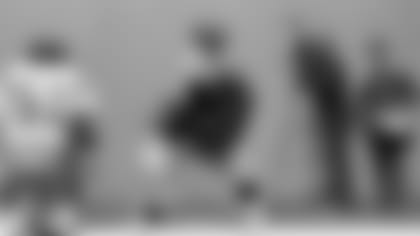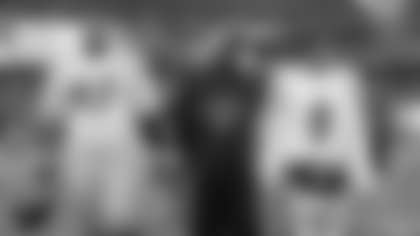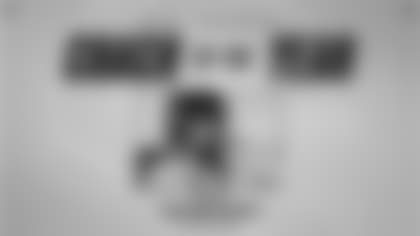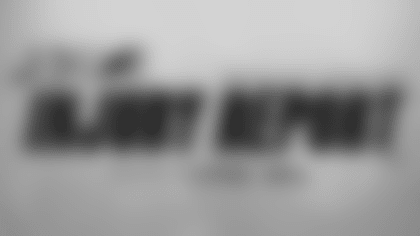**

Another in a series of stories chronicling the 52 playoff games in Steelers history.**
Strange things can happen in football game, and often this is written off as the natural course of events in a sport where the ball is oblong and therefore bounces in unpredictable ways. Strange things happened throughout the entire 1982 NFL season, and it had nothing to do with the shape of the ball.
The Steelers entered the 1982 season having been spectators to the two previous NFL postseasons, and their roster was looking less and less like the one that dominated the sport through the 1970s. The team that had made the playoffs eight times and won four championships during that decade was aging and changing, and there were pains associated with all of it.
The team that reported to Saint Vincent College in the summer of 1982 still had 13 players who owned the full complement of four Super Bowl rings, and most of them still held significant roles on the team. But they were aging, and professional football is a game for the young.
There were Terry Bradshaw, Franco Harris, Lynn Swann and John Stallworth, Mike Webster and Larry Brown for the offense; L.C. Greenwood, Jack Lambert and Jack Ham, Mel Blount, J.T. Thomas and Donnie Shell for the defense. And of course, Chuck Noll was still the coach.
The Steelers were coming off a 1981 season in which things fell apart for them after Terry Bradshaw injured a hand in Oakland in early December and was lost for the rest of the season. At the time of Bradshaw's injury, they were 8-5, but without their starting quarterback, and also without backup Cliff Stoudt by virtue of his infamous encounter with a punching bag in a Seattle bar, the Steelers lost three straight and finished their 1981 schedule at 8-8.
If the Steelers were graying around the gills, they still were a marquee attraction, and their schedule for 1982 reflected this status. They opened their 1982 season on a Monday night in Dallas against the Cowboys, and then they opened their home schedule six days later against the defending AFC champion Cincinnati Bengals.
As it turned out, the Steelers were up to the task.
The Cowboys had won 17 straight openers entering 1982, but with Harris rushing for 103 yards, with Bradshaw throwing for three touchdowns and with rookie placekicker Gary Anderson nailing two clutch field goals in the fourth quarter, the Steelers recorded a 36-28 upset win.
Then came the Bengals to Three Rivers Stadium, and Cincinnati arrived with a four-game winning streak over the Steelers. This was another wild game, and Bradshaw was even more spectacular. He completed 29-of-42 for 298 yards and three touchdowns, but it took a 42-yard field goal by Gary Anderson with 35 seconds left and then a Tom Beasley block of a 39-yard attempt by Jim Breech in the final five seconds of the fourth quarter to send the game into overtime. On the second play of overtime, Dwayne Woodruff's interception and return to the Bengals 2-yard line set up Bradshaw's touchdown pass to Stallworth for the game-winning points.
After two weeks, the Steelers were 2-0, with wins over two of the best teams in the NFL. Their starting quarterback had completed 46-of-70 for 544 yards, with six touchdowns and no interceptions, for a passer rating of 117.8. Their defense had become more opportunistic than it was impregnable, but five sacks and seven takeaways in two games translated into winning football.
Then everything stopped. Everything. For 57 long days.
The NFLPA called for a strike at midnight on Monday, Sept. 20, the day after the Steelers got to 2-0 with that win over the Bengals, and play wouldn't resume until the weekend of Nov. 21-22. That meant a 16-game season was whittled to nine, and instead of having division races and wild cards determine the playoff participants, the top eight teams from each conference would enter a Super Bowl tournament.
Everything you need to know about what the 1982 Steelers were after the strike compared to the kind of team they were before the strike can be found in Bradshaw's statistics. In the first game back, against an Oilers team that would finish 1-8, the Steelers won but Bradshaw was 16-of-40 for 226 yards, with three touchdowns and two interceptions. That translates into a passer rating of 63.2, roughly half of his efficiency before the strike and heavy on the turnovers.
From there, it was more of the same. Bradshaw would make plays, but he'd also make mistakes, and for a team that was now dependent on its passing attack, the remainder of the regular season was a seven-week roller coaster ride.
In a win over Kansas City, Bradshaw threw for three touchdowns; in a shutout loss in Buffalo he had 3 yards passing and two interceptions; in a 10-9 loss in Cleveland, he threw four interceptions; and in a win over new England, he passed for 282 yards and two touchdowns.
When the strike had been settled, the decision had been made to turn the playoffs into two eight-team tournaments, and then operate the whole thing according to brackets arranged via a seeding process. The Steelers finished the regular season at 6-3, but it's also fair to note that they were a rather mediocre 4-3 after the strike ended. Their record was good for the No. 4 seed in what would be known as the AFC Tournament. behind the Raiders, Miami and Cincinnati, and that meant they would host the No. 5 seed – San Diego – in the first round of the tournament.
Which Bradshaw would the Steelers get for the postseason? A little bit of both.
This playoff game against the Chargers, played on Jan. 9, 1983 at Three Rivers Stadium, will go down in history as one of the greatest games of Bradshaw's Hall of Fame career as well as one of the bitterest defeats in franchise history.
In 1979, the San Diego Chargers went into the AFC Playoffs as the No. 1 seed, but a loss to the Houston Oilers in the Divisional Round prevented them from even getting a shot at the Steelers in the AFC Championship Game. In 1981 the Chargers had made that step, but they lost in Cincinnati in a game played in temperatures even polar bears would consider on the chilly side. The 1982 San Diego Chargers were still explosive offensively, having ranked No. 1 in the NFL in points scored and passing yards, while their defense depended upon sacks (19) and takeaways (25) during the course of the nine-game regular season. These Chargers finished with the same 6-3 record as the Steelers, but they entered the AFC Tournament having won five of their previous six games.
The game opened with Steelers linebacker Guy Ruff recovering a Chargers fumble of the opening kickoff in the end zone for a quick touchdown, and then for the next three-and-a-half quarters the game belonged to Bradshaw. At one point he completed 15 passes in a row, and he finished the game with 28 completions in 39 attempts for 335 yards, with two touchdowns. But Bradshaw also threw two interceptions, the second of which served as a turning point in the game.
In the moments just before that turnover, the Steelers were holding a 28-17 lead with 11 minutes remaining in a game of which they were in complete control. Facing a third down situation, Bradshaw dropped back to pass, and after he escaped the contain of the Chargers pass rush he had a clear path to run for the first down. But instead of running, Bradshaw tried to depend on his right arm once again, but this time the pass was intercepted by Jeff Allen and returned to the Steelers 29-yard line.
In another of the examples of the 1982 Steelers defense being more opportunistic than impregnable, Mel Blount answered with an interception of Dan Fouts, but the play was nullified by a holding penalty on the Steelers. With new life, Fouts moved the Chargers offense down the field for a touchdown that came on an 8-yard pass to tight end Kellen Winslow and closed the Steelers' lead to 28-24.
On their ensuing offensive possession, the Steelers offense was able to grind out a couple of first downs to get close to midfield before John Goodson had to come on to punt. But instead of pinning the Chargers deep, Goodson, a barefoot punter, shanked one for only 20 yards to the Chargers 36-yard line.
Fouts moved the offense down the field methodically, and with one minute to play, he threw a 2-yard touchdown pass to Winslow, and the Steelers had been eliminated from the Tournament, 31-28.
|
Chargers |
|
3 |
14 |
0 |
14 |
|
31 |
|
Steelers |
|
14 |
0 |
7 |
7 |
|
28 |
|
TEAM |
QTR |
PLAY |
|
Pit |
1 |
Ruff recovered fumble in end zone (Anderson kick) |
|
SD |
1 |
Benirschke 25 FG |
|
Pit |
1 |
Bradshaw 1 run (Anderson kick) |
|
SD |
2 |
Brooks 18 run (Benirschke kick) |
|
SD |
2 |
Sievers 10 pass from Fouts (Benirschke kick) |
|
Pit |
3 |
Cunningham 2 pass from Bradshaw (Anderson kick) |
|
Pit |
4 |
Stallworth 9 pass from Bradshaw (Anderson kick) |
|
SD |
4 |
Winslow 8 pass from Fouts (Benirschke kick) |
|
SD |
4 |
Winslow 12 pass from Fouts Bernischke kick) |
|
TEAM STATISTICS | ||
|
|
SD |
Pit |
|
First Downs |
29 |
26 |
|
Third Downs |
9-14 (64%) |
6-12 (50%) |
|
Total Net Yds |
479 |
422 |
|
Plays-Avg |
71-6.7 |
62-6.8 |
|
Rushing Yds |
146 |
93 |
|
Att-Avg |
29-5.0 |
23-4.2 |
|
Passing Yds |
333 |
325 |
|
Att/Comp/Int |
42-21-0 |
39-28-2 |
|
Punts-Avg |
1-48 |
2-32.5 |
|
Penalties-Yds |
6-51 |
6-54 |
|
Fumbles-Lost |
3-2 |
1-0 |


- 1972 AFC Divisional Playoff
- 1972 AFC Championship Game
- 1973 AFC Divisional Playoff
- 1974 AFC Divisional Playoff
- 1974 AFC Championship Game
- Super Bowl IX
- 1975 AFC Divisional Playoffs
- 1975 AFC Champiionship Game - Super Bowl X - 1976 AFC Divisional Playoff - 1976 AFC Championship Game - 1977 AFC Divisional Playoffs - 1978 AFC Divisional Playoff - 1978 AFC Championship - Super Bowl XIII - 1979 AFC Divisional Round - 1979 AFC Championship - Super Bowl XIV - 1982 AFC Tournament





